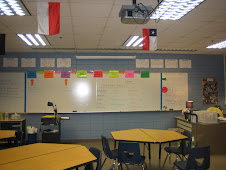Instructions on creating a blog from scratch can be found on Mr. Hatten's website.
The blog will be your group's visual aid for a presentation on your book on Finals Day. The presentation (and hence the blog) needs to include the following elements:
- Brief plot summary
- Setting--details, connection to themes, and artist or poetic representation (Haiku)
- Character development--describe the main characters (bubble map) and bring them to life with an artistic or poetic representation (sonnet). Character posts could also include analogies (remember your bridge maps) between the characters and pop culture and/or current events. Questions to consider: If you were casting a movie version of the book, whom would you cast? What political or public figures relate to your novel's characters? To discuss character development a great strategy is to compare and contrast the character at the beginning of the book with the same character at the end of the book. A double bubble map works well here. How an author develops a character through foils to other characters could also be discussed during the character portion of the presentation. Again, a double bubble for comparison and contrast will provide an active tool to facilitate a deeper discussion on character foils in the novel.
- Biographical information about the author and historical context information that is relevant to your book.
- Poetry’s connection to your novel. Does your author directly address the need for poetry in a person's life at a thematic level? If not, what can you infer about poetry's importance from the setting, plot, characters and other themes in the novel?
- Connections between your novel and the other ones being read during this world literature choice unit. Refer to the double bubble maps in your notebooks.
- Discuss music’s connection to your novel. Revisit the same types of questions that you did during poetry discussion day.
- Discuss art & your novel. Refer to the same questions that you asked during poetry and music discussion days.
- Discuss the role of science, religion, and philosophy in the lives of the characters in your novel. This discussion should lead to thematic connections that the author is making about some or all of these topics.
- Other Themes--What life lessons is the author teaching in your novel that were not discussed on music, poetry, art, science, religion and philosophy discussion days? Remember that theme analysis needs to go beyond a topic. Theme has action! Theme = topic + action verb + prepositional phrase and/or direct object. A great way to discover themes in a novel is to analyse the conflicts in the book. What are the causes and effects of the conflict? A Multi-flow map is a great tool for these conflict discussions that often lead to the deepest theme discussions.
Anytime that you use sources other than your brain, you need to cite your sources and paraphrase information so that it is in your own words on your blog. This includes Sparknotes! Remember that a hotlink to the exact web page that you used for a particular blog post is an easy and credible way to cite sources.
You do not need to create all of your blog posts at the last minute. You can build posts throughout the unit by having members compose reflections that capture your book club discussions. You can even scan some of the Thinking Maps that you create in your notebook and any artwork that you create. Add those jpeg files as images to a blog post.





